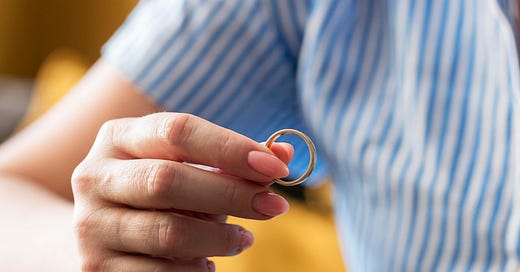How To Use Your Oura Ring Without Losing Your Mind
From data to embodiment: how to use your wearable to feel first, track second.
Note: this isn’t sponsored by Oura. I’m not here to sell you on a gadget (although I do happen to love mine). This is about something bigger: how to use your data (from any wearable) to get out of your head, into your body, and actually feel better for it.

I had a conversation with a journalist the other day about anxiety caused by Oura Rings.
(Yes, I AM hoping to be featured in the Daily Mail, thanks for asking. Although my current features pile already makes me dance around my kitchen.)
Because it’s a thing. We’re stressed beyond all comprehension, working like maniacs, feel the pressure to perform constantly, and our attention spans are basically mush…
And I can wear a tiny device on my finger to help me feel better? Yes please.
Except sometimes they actually make us feel worse. I’ve at least two friends who’ve thrown their rings in a drawer multiple times. And the fact I had a conversation with a journalist about this kind of anxiety recently really does mean it’s a big deal.
But I’m here, wearing my Oura Ring as I type these words, and I can happily say it’s been a brilliant investment because I’ve learned how to use it properly.
Why the anxiety?
Because data does not equal embodiment.
You’re likely reading this as either an Oura Ring owner, another type of wearables owner, or someone on the brink of investing. And why do we invest? These things promise us improvements on our sleep, movement, stress-levels, and overall health. What an investment. Take my money.

The problem comes, though, when we — us well-meaning, productivity-focused humans — are left with a pile of data we likely struggle to interpret.
One friend in particular told me her ring showed high stress levels when she was feeling pretty calm. Cue banishment to the drawer — it was bloody wrong AND it gave her another thing to worry about. (That conversation actually ended up being the foundation for this article about stress.)
Interoception is what we should be learning from this data — the ability to feel more and feel better for it — but instead we’re left simply interpreting. And when we’re exclusively outsourcing our awareness like this (because that’s so often what happens when we use wearables) we’re unknowingly creating anxiety.
We’re stuck in a loop of thinking about our Oura Ring data, rather than feeling it. And that’s the issue.
Let’s feel instead of interpret
I feel like I add this to every single fucking thing I ever write, but it bears repeating: we’re human BEings, not human DOings. Or maybe to make it more contextually specific: we’re feeling machines, not data machines.
So if you’re noticing anxiety because of your wearable, let’s course-correct with my totally excellent five-day plan to rebuild your relationship to your ring (and your body):
The 5-step Oura Ring anti-anxiety plan:
Do this over 5 days, two weeks, a morning… it doesn’t matter. Regardless of how long it takes you, go through the following steps to reframe your brain on wearables:
Day 1. Take it off. I’m serious. Anxiety is the opposite of what it should be doing for you. Take it off and (lovingly) put it in a drawer until later.
Day 2. Establish the issue. Is it giving you sleep anxiety? Stress anxiety? Movement anxiety? All of the above?
Day 3. Remove the damn pressure. It’s this (mostly self-inflicted) pressure I see all the time in my program, and when we give ourselves permission to release the pressure, and let things be as they are (for instance: letting sleep be ‘imperfect’ — you’ve got by on rubbish sleep before, so you’ll be just fine doing it again), we can ironically find space around the thing (i.e. sleep) and take a step towards improvement.
Day 4. Learn to feel the issue. Let’s stick with the sleep problem. What does it feel like in your body to get terrible sleep versus brilliant sleep? And what things do you think impact your sleep?
As for me, I can confidently tell you that if I have a decent whack of sugar in the afternoons (and I’m not even talking about much) my sleep will be negatively impacted. There goes my Ben & Jerry’s addiction. I also know that if I take a time-out in the afternoons to rest with my current daft fiction read, you guessed it, my sleep improves.
Day 5. Has this reduced your anxiety around it? Only when you can say yes to this, can you put the ring back on. And then we move onto changing the way you use it
A new way of using your Oura Ring
When you wear your ring, rather than like a scorecard, treat it like an invitation. You’re not trying to win at health, you’re simply trying to come home to yourself in order to see these improvements you got the damn thing for in the first place.

So instead of asking what’s the data today?, ask: what does this feel like in my body?
Here’s what that might look like in practice:
When your ring says you’ve had a great night’s sleep, pause and notice: Where do I feel rested in my body? What does “rested” even mean to me? What does that feel like? What happened yesterday to get me to good sleep? Your Oura Ring can tell you that you slept, but not how it felt to be you in that sleep or after it.
When it flags stress, don’t just clock the word and panic. Make sure to learn what different stress looks like, first of all. And then notice what kind of stress this is — good stress (it exists), bad stress (it’s inevitable)? Where does this tension sit for you? What can you do to express that stress and come back to ease?
And if your readiness score drops? Use it as a cue to ask: What does this low readiness feel like in my body? What would support me today? Maybe it’s less caffeine. Maybe it’s moving slower. Maybe it’s letting the to-do list stay undone. Softness without guilt — that’s the mission.
Want to understand this inner landscape on a deeper level? My article Nervous System 101 is THE guide to help.
This way, we’re letting the ring be a guide rather than the expert (because, my friend, YOU’RE the expert). We want to let the ring teach us how to be a human again, instead of outsourcing to it all our agency.
This is how you shift from interpreting your body to actually feeling your body. It’s the difference between being a walking spreadsheet and being someone who’s living inside themselves.
That’s what wearables are meant for, by the way — not to override your intuition, but to reconnect you to it. To give you language for the sensations that are already there.
Try this: a grounding movement practice to help you feel before you track
Morning Flow: Balance Focus (16 mins)
If your wearable’s been shouting at you about stress or readiness, but your body’s telling a different story, this class is your opportunity to tune in and find out what’s really going on.
This isn’t just about balance in the physical sense (though yes, we’ll challenge your single-leg strength and lower body stability); it’s also about balancing how much you think you know from your data, with what you feel in your actual body.
Expect a steady, centring 16 minutes designed to leave you more grounded, more connected, and way more ready to face the day — wearable or not.
👉 Click here to take the class inside The Yoga Revolution (and favourite for later)
Free subscribers: you’ll need to be a paid Joyful member to access The Yoga Revolution’s library (and this class), but joining is easy. You’ll get instant access to this practice and a full library of movement and nervous system reset classes designed to help you feel better from the inside out.
Learn more about upgrading here.
Let’s stop outsourcing our wellbeing and start living it.







I really resonated with this post. I bought an Oura ring last year, excited to track things like my sleep, fitness etc and thought the knowledge would either make me feel better or give me some motivation. I was quite shocked when I realised it had kind of become a source of stress for me at times, and I had to take breaks from wearing it. Thank you for the post!